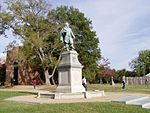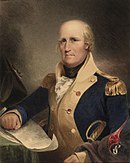Portal:Virginia
The Virginia Portal  Virginia, officially the Commonwealth of Virginia, is a state in the Southeastern and Mid-Atlantic regions of the United States between the Atlantic Coast and the Appalachian Mountains. The state's capital is Richmond and its most populous city is Virginia Beach, though its most populous subdivision is Fairfax County, part of Northern Virginia, where slightly over a third of Virginia's population of 8.72 million live. The Blue Ridge Mountains cross the western and southwestern parts of the state. The state's central region lies predominantly in the Piedmont. Eastern Virginia is part of the Atlantic Plain, and the Middle Peninsula forms the mouth of the Chesapeake Bay. The fertile Shenandoah Valley fosters the state's most productive agricultural counties, while the economy in Northern Virginia is driven by technology companies and U.S. federal government agencies, including the U.S. Department of Defense and Central Intelligence Agency. Hampton Roads is also the site of the region's main seaport and Naval Station Norfolk, the world's largest naval base. (Full article...) Selected article
Skyline Drive is a 105-mile (169 km) road that runs the entire length of the National Park Service's Shenandoah National Park in the Blue Ridge Mountains of Virginia, generally along the ridge of the mountains. The drive's northern terminus is at an intersection with U.S. Route 340 (US 340) near Front Royal, and the southern terminus is at an interchange with US 250 in Rockfish Gap, where the road continues south as the Blue Ridge Parkway.
A park entrance fee is charged at the four access points to the drive. Skyline Drive is a two-lane road that has 75 overlooks providing views of the Shenandoah Valley to the west and the Piedmont to the east. The drive provides access to numerous trails, including the Appalachian Trail, and it is also used for biking and horseback riding. Skyline Drive is the main road through Shenandoah National Park and has access to campgrounds, visitor centers, and resorts such as Skyland Resort and Big Meadows. The scenic drive is particularly popular in the fall for leaf peeping when the leaves are changing colors. Skyline Drive is designated a National Scenic Byway and a National Historic Landmark and is listed on the National Register of Historic Places. Plans for the road date back to 1924 when a national park was planned in the Blue Ridge Mountains of Virginia and the main feature was to be a "sky-line drive" providing views of the surrounding land. Groundbreaking for Skyline Drive took place in 1931. The first section, which originally was to run from Rapidan Camp to Skyland, was extended between Swift Run Gap and Thornton Gap and opened in 1934. The Civilian Conservation Corps played a large part in constructing Skyline Drive. Improvements have been made to the roadway since it was built. Skyline Drive was added to the National Register of Historic Places in 1997, became a National Scenic Byway in 2005, and was designated a National Historic Landmark in 2008. Selected biography
George Rogers Clark (1752 – 1818) was a soldier from Virginia and the highest ranking American military officer on the northwestern frontier during the American Revolutionary War. He served as leader of the Kentucky (then part of Virginia) militia throughout much of the war. Clark is best known for his celebrated captures of Kaskaskia (1778) and Vincennes (1779), which greatly weakened British influence in the Northwest Territory. Because the British ceded the entire Northwest Territory to the United States in the 1783 Treaty of Paris, Clark has often been hailed as the "Conqueror of the Old Northwest."
Clark's military achievements all came before his 30th birthday. Afterwards he led militia in the opening engagements of the Northwest Indian War, but was accused of being drunk on duty. Despite his demand for a formal investigation into the accusations, he was disgraced and forced to resign. He left Kentucky to live on the Indiana frontier. Never fully reimbursed by Virginia for his wartime expenditures, Clark spent the final decades of his life evading creditors, and living in increasing poverty and obscurity. He was involved in two failed conspiracies to open the Spanish-controlled Mississippi River to American traffic. After suffering a stroke and losing his leg, Clark was aided in his final years by family members, including his younger brother William, one of the leaders of the Lewis and Clark Expedition. Clark died of a stroke on February 13, 1818. This month in Virginia history
Random Virginia articleA random generator will select an article about… 
(note: generator may be slow) Things you can do
Tasks
Selected image 1630 edition of John Smith's map of the Chesapeake Bay (North to the right) Did you know -
Fact sheet
State symbols:
Government
Related portalsVirginia topicsSubcategoriesSelect [+] to view subcategories
Associated WikimediaThe following Wikimedia Foundation sister projects provide more on this subject:
Discover Wikipedia using portals |



























